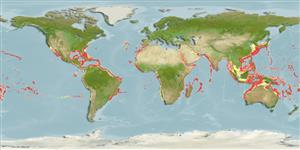>
Aulopiformes (Grinners) >
Notosudidae (Waryfishes)
Etymology: Scopelosaurus: Greek, skopelos = a lantern fish + Greek, sauros = lizard (Ref. 45335).
Eponymy: Dr Hugh McCormick Smith (1865–1941) was an American physician (1888) who became an ichthyologist. [...] (Ref. 128868), visit book page.
Environment: milieu / climate zone / depth range / distribution range
Ecologia
marino benthopelagico; oceanodromo (Ref. 6689); distribuzione batimetrica 50 - 815 m (Ref. 13608). Tropical; 40°N - 30°S
Eastern Atlantic: off Madeira and at 20°N 30°W. Western Atlantic: 34°N to 20°S, with some larval drift up to 40°N. Elsewhere, Indian and Pacific Oceans between 20°N and 30°S.
Size / Peso / Age
Maturity: Lm ? range ? - ? cm
Max length : 25.0 cm TL maschio/sesso non determinato; (Ref. 6602)
Short description
Chiavi di identificazione | Morfologia | Morfometria
Spine dorsali (totale) : 0; Raggi dorsali molli (totale) : 10 - 12; Spine anali: 0; Raggi anali molli: 17 - 19; Vertebre: 53 - 56. Blackish on head and back; paler below (Ref. 6602). No distinct black spot surrounding anus (Ref. 13608).
Larvae are epipelagic, young inhabit the layers between 50-200 m, adults benthopelagic and found deeper than 500 m over continental and insular slopes (Ref. 6552, 6602). Mesopelagic (Ref. 58302). Feeds mainly on zooplankton. Extensive migrations by juveniles and adults, probably for feeding in the subtropical belts. Spawning occurs in tropical waters, especially in the western part of the Atlantic Ocean (Ref. 6689).
Life cycle and mating behavior
Maturità | Riproduzione | Deposizione | Uova | Fecundity | Larve
Krefft, G., 1990. Notosudidae. p. 361-364. In J.C. Quero, J.C. Hureau, C. Karrer, A. Post and L. Saldanha (eds.) Check-list of the fishes of the eastern tropical Atlantic (CLOFETA). JNICT, Lisbon; SEI, Paris; and UNESCO, Paris. Vol. 1. (Ref. 6552)
IUCN Red List Status (Ref. 130435: Version 2024-1)
Threat to humans
Harmless
Human uses
Pesca: di nessun interesse
Strumenti
Special reports
Download XML
Fonti Internet
Estimates based on models
Preferred temperature (Ref.
123201): 9.6 - 20.6, mean 14.5 °C (based on 680 cells).
Phylogenetic diversity index (Ref.
82804): PD
50 = 0.5001 [Uniqueness, from 0.5 = low to 2.0 = high].
Bayesian length-weight: a=0.00295 (0.00121 - 0.00721), b=3.18 (2.96 - 3.40), in cm total length, based on LWR estimates for this (Sub)family-body shape (Ref.
93245).
Trophic level (Ref.
69278): 3.4 ±0.45 se; based on food items.
Fishing Vulnerability (Ref.
59153): Low vulnerability (15 of 100).
